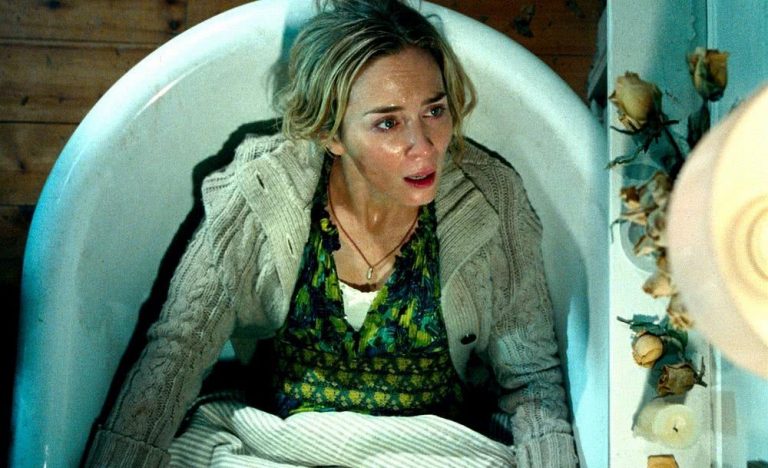Genre films made by people not widely known for their love of this mode of filmmaking are often interesting precisely because, like their makers, they don’t quite fit in the tradition. Jordan Peele’s Get Out is the most recent example: mixing together horror and satire, the Oscar-winning thriller also has the sense of humour for which its sketch-comedian-director is famous. Peele’s wit makes his social commentary even more biting, although critics claiming Get Out to be fully groundbreaking for its take on racism ignore a long tradition of socially conscious horror cinema, from James Whale’s Frankenstein in 1931 (the creature’s ruin by his own makers echoes that of Black Americans doomed by their past in slavery) to George Romero’s tragically killed African-American hero in Night Of The Living Dead in 1968.
Collaborating with experienced horror screenwriters Bryan Woods and Scott Beck (they co-wrote and co-directed a few low-budget horror films, such as Nightlight in 2015), comic actor John Krasinski co-wrote and directed A Quiet Place, the almost silent alien-invasion film he also stars in with his wife, Emily Blunt. Still best known for his turn as the sweet Jim Halpert in The Office, Krasinski’s dip into horror may surprise some viewers, but the end result feels very much like him: A Quiet Place may be effective as a collection of jump-scares, but it also has Krasinski’s beloved tenderness. It doubles as an alien film and a deeply emotional family drama about protecting your offspring and loving them unconditionally under any circumstances.
Opening in medias res, A Quiet Place doesn’t bother explaining the how and why of the alien invasion that has seemingly eradicated most of humanity. The first scene establishes the simple premise purely via mise-en-scene, while also indicating the sensitivity at the story’s core. In an abandoned supermarket, dust-covered kids and their mother (Blunt) are walking on tiptoes, delicately grabbing pillboxes from the shelves and communicating in sign language. The youngest boy (Cade Woodward) still hasn’t completely mastered ASL and draws a rocket in the dirt, mimicking the best he can to his deaf older sister (Millicent Simmonds, the star of Todd Haynes’ misfire Wonderstruck) that this is how they will escape. When he comes close to accidentally activating the sounds of an electronic toy rocket ship, his relatives turn pale and gently scold him; he’s just a kid. Kids are loud, and this truism will become the main problem in an environment where noisiness has turned deadly, as well as an evocative metaphor for the struggles of parenthood.
Spoiler: the child eventually makes too much noise and is torn apart (off screen) by a ruthless alien. Already, loud children are literally and metaphorically ripping apart the family unit. The sister feels that her father (Krasinski) will never forgive her for the accident. The parents, meanwhile, blame themselves, as they are supposed to protect their children, but try to move on in order to survive. The realism of this family dynamic, revolving as it does around things (literally) unspoken and pent-up, is the heart of the film.
The fantasy aspect of the story allows these relationship struggles to be expressed in more dramatic strokes. Under such extreme circumstances, loving, trusting and, most importantly, communicating with each other is very difficult, but paradoxically more important than ever. Family life, the film proposes, is the struggle to make your voice heard without creating a dangerously noisy household that would end up being toxic to everyone involved.
The analogy is taken to another level when, months later, it appears that the mother is heavily pregnant. Now living in a deserted but functional house in a cornfield, the family prepares a soundproof room for the newcomer. Slow dancing with earphones on, Krasinski and Blunt make for a sweet couple, and together beautifully portray parenthood as the sharing of both love and fear for the future. With their children, they are patient and affectionate, refusing to let the monsters outside turn them into soulless animals dedicated only to survival. This humility translates into the performances. Nobody, not even Dad, pretends not to be scared when the creatures come too close, and Krasinski’s wholesome and expressive face, combined with his muscular body, makes him the ideal strong but kind fatherly archetype.
Love Music?
Get your daily dose of metal, rock, indie, pop, and everything else in between.
Under such extreme circumstances, loving, trusting and, most importantly, communicating with each other is very difficult, but paradoxically more important than ever.
As is common — and arguably unavoidable, if not essential — in genre cinema, A Quiet Place references several iconic horror films, but does so modestly. Emily Blunt standing face to face with a blind extraterrestrial whose sense of hearing is hyper-developed recalls Sigourney Weaver and the titular Alien, only Blunt is also carrying a newborn — a amusing and symbolic touch that anchors the image in Krasinski’s film beyond superficial borrowing. The cornfield naturally becomes the site of Signs-like chases while still belonging to this film’s universe, and Blunt’s bloody hand hitting against the shower glass after she’s given birth recalls both Psycho’s infamous murder sequence and, to this viewer, Titanic’s heated sex scene (the jump from intercourse to childbirth isn’t that difficult to make, after all.).
Original ideas are present as well as the characters think up clever tactics to save themselves, such as using fireworks to drown out their own sounds (which also calls back Shyamalan-style to their son’s claim that rockets would save them, and to his subsequent death because of a tiny rocket): the best horror movies find inspiration in the limits of their hypothesis. Ideally, they also avoid believing in their fantasy too much to become smug, and in its final moments, A Quiet Place both solves and acknowledges the latent goofiness of its premise. The easy but uplifting ending is also satisfying for the heroes it makes: in Krasinski’s fable, the family is saved by its strong and intelligent women.
A Quiet Place is in cinemas now. For more film reviews, check out our thoughts on the new Australian documentary Have You Seen The Listers?


































